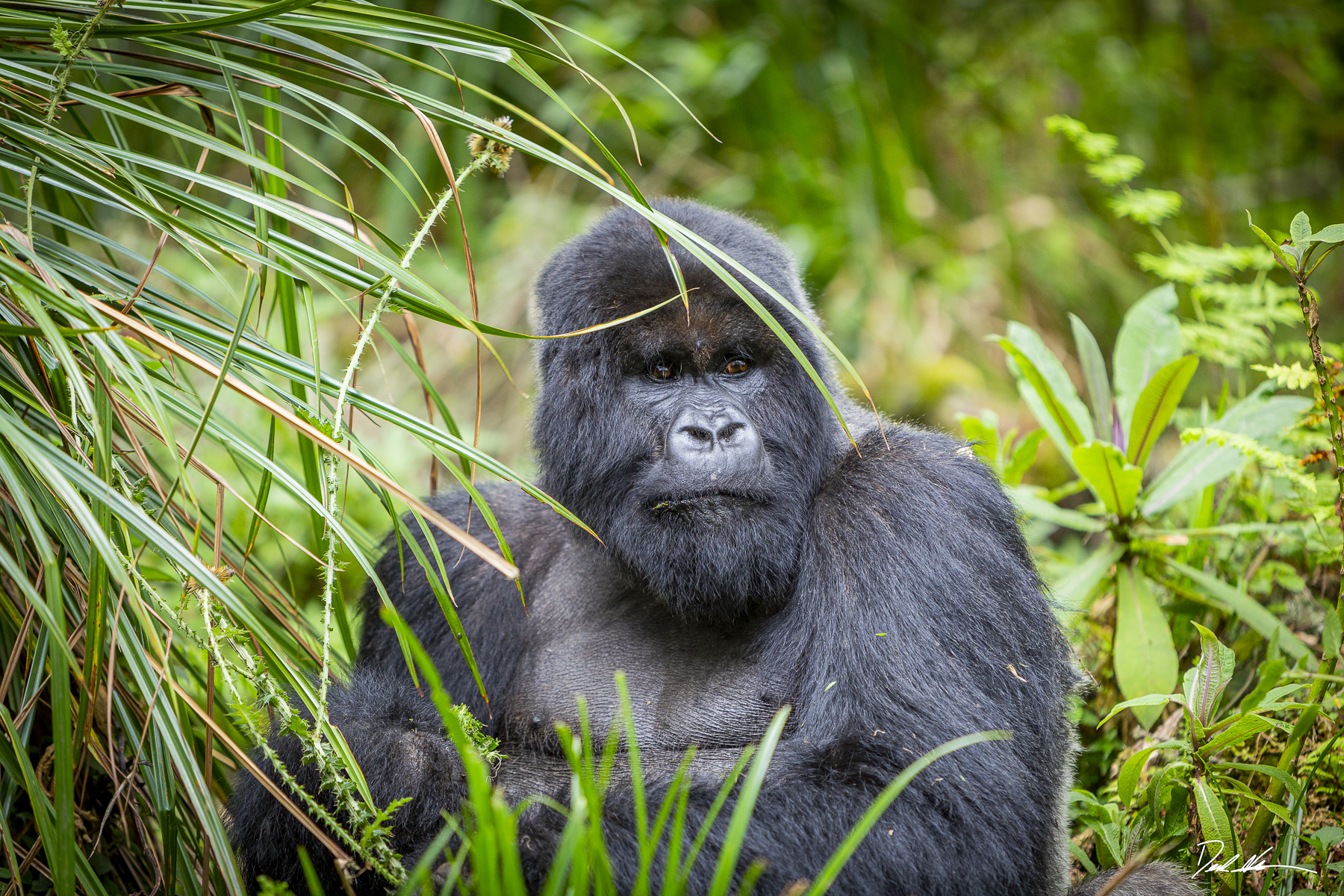
Gorilla Trekking | How to visit mountain gorillas and why you will return again and again.
My first experience trekking with gorillas in Rwanda completely changed my life. To that point, back in 2016, I was a traveler simply for the joy of experiencing the world for all of its beauty. The adventure of new places, unfamiliar faces, and food….oh the food. However, after my experience gorilla trekking in Rwanda, my focus on travel became searching for experiences that not only enhanced my own life but also gave back to the communities and nature I was experiencing as a traveler.
There is something about spending time in a gorilla habitat, no walls, no cages, just exposed to their hospitality that touches the soul. Something about the way a mountain gorilla looks into your eyes. Initiates a connection with you. Time stands still. You freeze. I am now a full-time professional nature and wildlife photographer. No doubt I was drawn to animals, but I knew that after this experience, this is what I wanted to do for the rest of my life. As with most travel, planning such an adventure is half the fun. I’m going to take you on a journey through my own first-hand experiences and what you can expect from trekking gorillas.
How to go gorilla trekking?
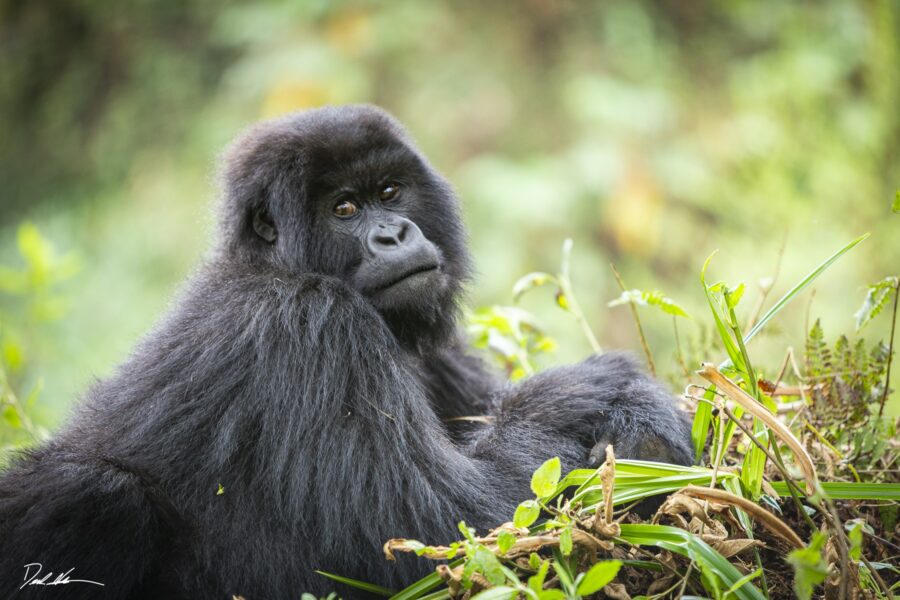
(Derek Nielsen Photography | Open Edition Fine Art Print – Contemplation)
Gorillas, particularly mountain gorillas, can be found in 3 countries: Rwanda, Uganda, Democratic Republic of Congo (DRC). Each country offers its own unique experience and all at different price points. Currently, Rwanda and Uganda are the more popular destinations for mountain gorilla trekking. However, with DRC recently being added to the East African Community, gorilla trekking will become safer and more popular there. Of these three countries, gorillas can be found in 4 national parks: Virunga National Park (DRC), Bwindi Impenetrable National Park (Uganda), Mgahinga Gorilla National Park (Uganda), and Volcanoes National Park (Rwanda).
Is gorilla trekking safe?
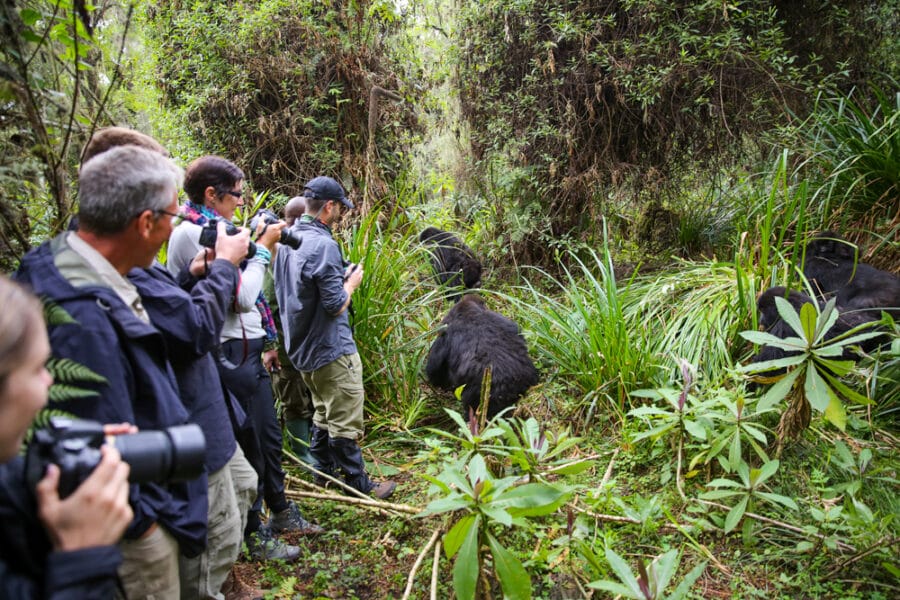
This is the number one question I get asked when I visit mountain gorillas. Is it safe to trek with mountain gorillas? Yes, absolutely, yes. About 50,000 people visit gorillas each year. While doing my research for this article, I could not find a single statistic stating the number of gorilla attacks on humans per year. These animals are very well monitored, and such an occurrence would have to be dealt with. In general, mountain gorillas are incredibly calm, shy vegetarians completely unconcerned with the presence of humans in their habitat. However, it can happen, but humans are usually to blame.
Before my first trip to Volcanoes National Park, I looked up gorillas attacking humans to prepare myself for anything. I was admittedly nervous the first time. The only footage I could find was two incredibly “foolish” (for the sense of keeping this PG) humans who picked up a baby gorilla and tossed it to the other person. Within moments, an adult, probably dad, came in clubbed the man holding his baby, and took off into the forest.
If you use any basic common sense, your time with the gorillas will be nothing but completely euphoric. For your safety and the safety of the gorillas, a team of expert rangers will brief you on safety before your encounter, keep control of the engagement during your visit, and assist you if any emergencies arise. The rangers use a low growling sound, like a long throat clear, to let the mountain gorillas know everything is calm. During your actual encounter with the gorillas, a set of rules and guidelines are used to keep everyone safe.
- Maintain 21 feet between you and the gorillas when at all possible. This is never easy. Gorillas are naturally curious. This guideline gives the gorilla control. They will approach you, but inside of 21 feet, you should not approach them to avoid provoking one who does not want to be approached. This also helps keep them from getting sick from our germs.
- Where your mask. Gorillas are now comfortable with seeing humans in facemasks due to Covid-19. Although you will be tested before visiting them, it is important to leave your mask on during the visit.
- Avoid prolonged direct eye contact with an individual. They may see you as a challenge.
- Stay low and move slowly.
- Do not reach out and touch them. As tempting as it is, they may be surprised and attack. Remember, these are wild animals. Don’t touch wild animals.
- Don’t feed the gorillas or carry anything on your body that may smell like food.
- Secure all objects close to your body such as cameras, binoculars, or walking sticks.
- If a gorilla moves quickly toward you or charges, remain calm and do not run. These displays are often a bluff or a warning, but don’t run.
- Absolutely no flash photography. This can startle the animal and cause it stress. Stressing an animal is never a good thing. Nobody likes a flash going off in their eyes. I know sometimes the conditions can be difficult but in a later section, I will explain how to get great images in low light.
- Stay with your group unless otherwise advised by your rangers. They can usually tell who is comfortable around wildlife and may pull you aside to see something unique.
- Always listen to your rangers. These women and men spend their lives around these beautiful animals. They know everything about them, including their personalities. They will keep you safe and ensure you have the life-changing experience we are all looking for.
Where are mountain gorillas found?
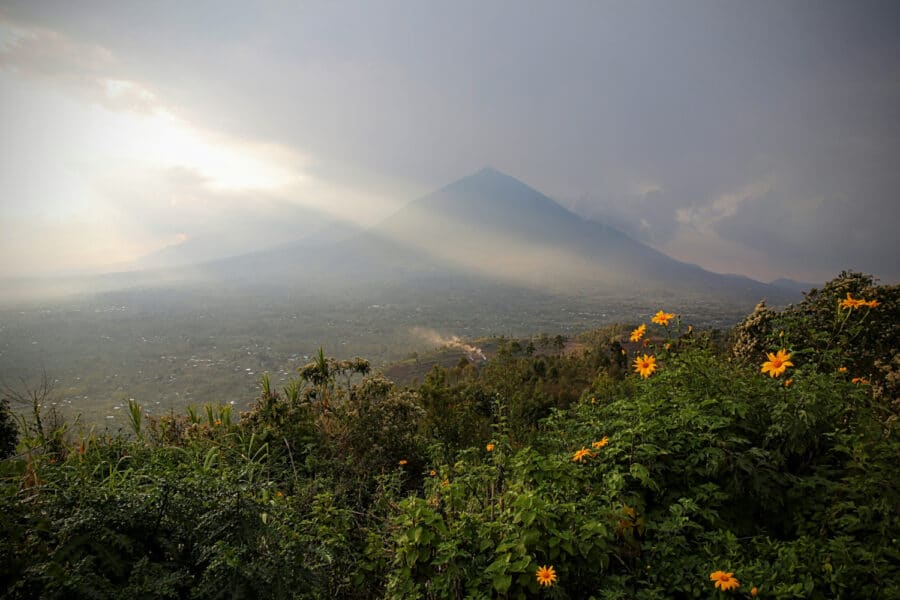
As described earlier, mountain gorillas can be found in Rwanda, Uganda, and DRC. The western edge of the East African Rift. This active volcanic zone expels eight volcanoes, making the Virunga Mountains. All but two of these volcanoes are dormant. One of the two active volcanoes most recently erupted in May of 2021. Inside of these mountains, the remaining portions of the Albertine Rift Montane Forests are home to the gorillas and make up a majority of mountain gorilla habitats.
Sadly, most of these ancient forests have already been cleared for human development. Conservation efforts are underway to regrow this type of forest to allow the expanding gorilla population room to grow. Dense, thick vegetation blankets the water-saturated earth, making it a bit of a challenge to traverse the landscape. Each park is a little different. Human development and geography make accessing the mountain gorillas different for each park.
- Volcanoes National Park, Rwanda – Located in the far northwestern part of Rwanda, Volcanoes National Park sits at an unexpected 7,700 feet, rising to 14,786 feet. The 160sqkm park shares borders with both Uganda and DRC. Home to American primatologist Dian Fossey, who established her research base at a place between the Visoke and Karisimbi volcanoes. She is known as the founder of gorilla conservation efforts in the region, where she tragically gave her life to saving these beautiful animals in 1984. After her murder, a tomb was created at the research center, where she is buried next to her favorite gorilla, Digit. This park is home to an estimated 340 of the 1063 remaining mountain gorillas left in the wild. There are 180 species of birds found in the park, several of which are endemic to the region. Other park inhabitants include buffalo, elephants, golden monkeys, bush pigs, and various antelope.
- Virunga National Park, DRC – This is the least traveled national park of the four. The security of guests inside the park remains its biggest threat to establishing itself amongst its neighbors. The park is home to ⅓ of the remaining mountain gorillas. With over 3,000 plant and wildlife species, Virunga is the most biodiverse of the group. Eastern gorillas can be found roaming parts of this park as well. Unlike their mountain gorilla relatives, they roam across the great forest of the Albertine Rift. The two active volcanoes, Mount Nyiragongo and Nyamurangira, of the region’s volcano system can be found inside the park. With all the beauty this park has to offer, it is only a matter of time before gorilla trekking helps stabilize the region. Until then, my recommendation is to do your research and understand the safety concerns of entering Virunga National Park.
- Bwindi Impenetrable National Park, Uganda – Home to half the world’s remaining populations of mountain gorillas, this unique park is one of Africa’s largest remaining portions of Afromontane lowland forest. The park covers 32,000 ha and has the largest number of tree and fern species in East Africa. This park is separated from the others on the list by human development and heavily relies on gorilla trekking for tourism. Located an 8-10 hour drive from Entebbe, most tourists lump in several attractions to help break up the tour. However, the 459 known gorillas and over 200 butterfly species will help energize tired travelers and make it all worth the hours spent getting there.
- Mgahinga Gorilla National Park, Uganda – Located directly across the border from Rwanda, this national park is home to 3 inactive volcanoes: Mount Muhabura, Mount Gahinga, and Mount Sabyinyo. Home to the smallest number of protected mountain gorillas, around 30 individuals split into four groups, this national park is an easy day trip to visit while visiting Rwanda for those looking to check another country off their list and get a little different experience.
How hard is gorilla trekking?
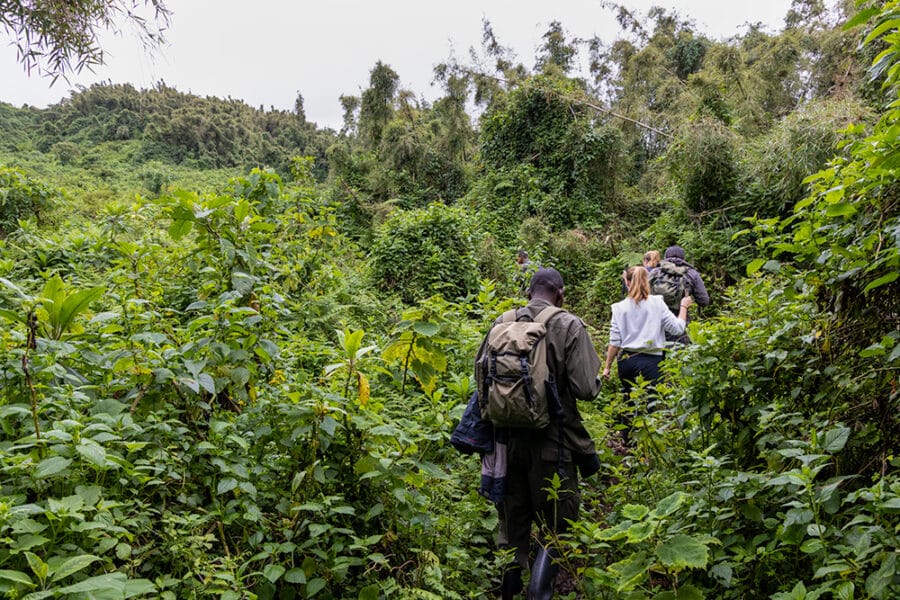
On a scale of 1 to 10, 1 being a trip to the zoo and ten being climbing Mount Everest, I would put gorilla trekking at a 4. Saying that, it can be more challenging for people with disabilities, those who are greatly out of shape, or anyone with balance issues. However, it can be done by all. Before you are assigned to a gorilla family to trek, your guide has a meeting with the park staff to explain his or her group’s particular abilities. From that conversation, the park staff will assign your group to various levels of difficulty. In all three times, I trekked with gorillas, my group had individuals with disabilities, older travelers, and fit young people. Nobody is left behind. Everyone has an incredible experience. For those of you who want a more intense physical experience, ask your guide to be paired up with a challenging group.
An average trek takes 2-3 hours with 1 hour of actual time with the gorillas. Longer treks can take 5-8 hours, depending on the gorilla’s movement on a particular day. In extreme cases, the gorillas will be unreachable due to their location. With proper hiking equipment, no other special gear is needed. Before beginning the slow, steady walk up the volcano or mountain, your lead ranger will ask if anyone needs a porter to assist them. I highly recommend taking one for two reasons: 1) there is no shame in having someone help you up some of the more challenging parts of the hike. There will be uneven surfaces, slippery mud, and a few big technical sections that the porter will easily be able to prevent you from ending up covered in mud. In the end, that is the worst that will happen. 2) By hiring a porter, you are supporting the local community and assisting in gorilla conservation.
Depending on what trek you decide you want to do, 1-2 liters of water should be plenty. Bring a quick snack to boost energy (leave it in your pack while with the gorillas). If you feel like you are unsure of your ability or fitness level, starting a light fitness routine 2-3 weeks ahead of your trip consisting of cardio, light resistance training, and mobility will be plenty. There is no need for most individuals to begin a vigorous exercise routine.
Best time of year to visit Volcanoes National Park, Rwanda
Just like most tropical regions of the world, there is not a hot or cold season like the other portions of the world but a wet and dry season. Some places have two wet sessions. For those looking to get the most consistent dry weather, June and July tend to be the best months. During this time, the trekking is easier from easier trail conditions. September, October, and November are pretty wet. December, January, and February see a bit of rain relief but can also be wet. March and April are the wettest months of the year before finally beginning to clear in May. Check out the links to these individual climate maps to give you a better idea of weather patterns across all the parks. Volcanoes National Park. Bwindi Impenetrable National Park. Park Virunga National Park.
How expensive is it to trek with gorillas?
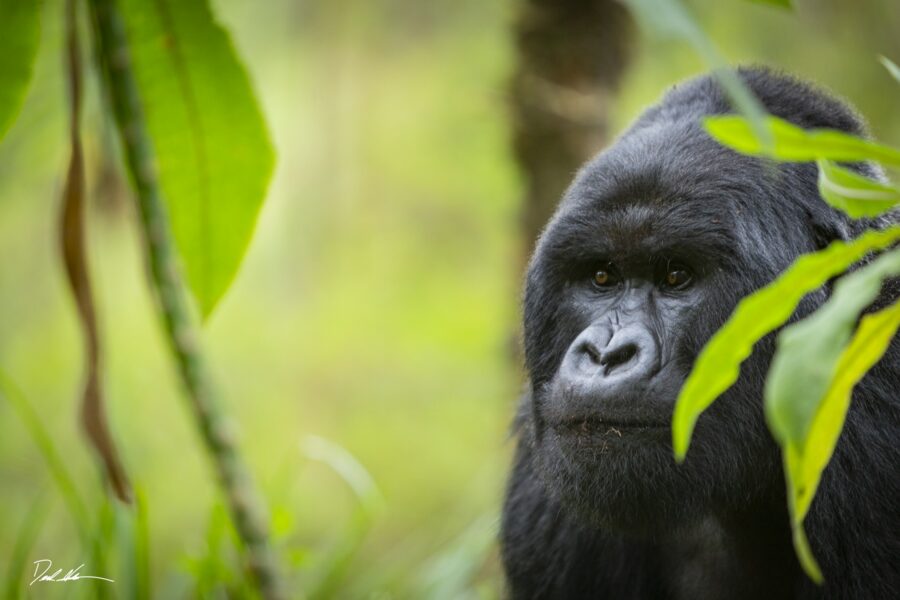
(Derek Nielsen Photography | Limited Edition Fine Art Edition of 100 – Stage Left)
For me and most people, this is the limiting factor. Gorilla trekking is not cheap. As of 2022, the prices for gorilla permits are:
- Rwanda – $1,500 per person per hour, $1,050 if visiting other national parks during the low season, $15,000 for private group tours, and $30,000 for a three day behind the scenes tour
- Uganda – a bit cheaper for basically the same experience: $700 per person per hour, $1,500 for a 4-hour habituation experience
- DRC – The current lowest budget experience to see gorillas is $400 in Virunga National Park
Each location has its pros and cons depending on how you like to travel and how much time you have. Because Volcanoes National Park in Rwanda is only 2 hours from the easily accessible capital, Kigali, travelers on a budget or those who prefer more luxurious accommodations prefer Rwanda.
How do I get a gorilla trekking permit?
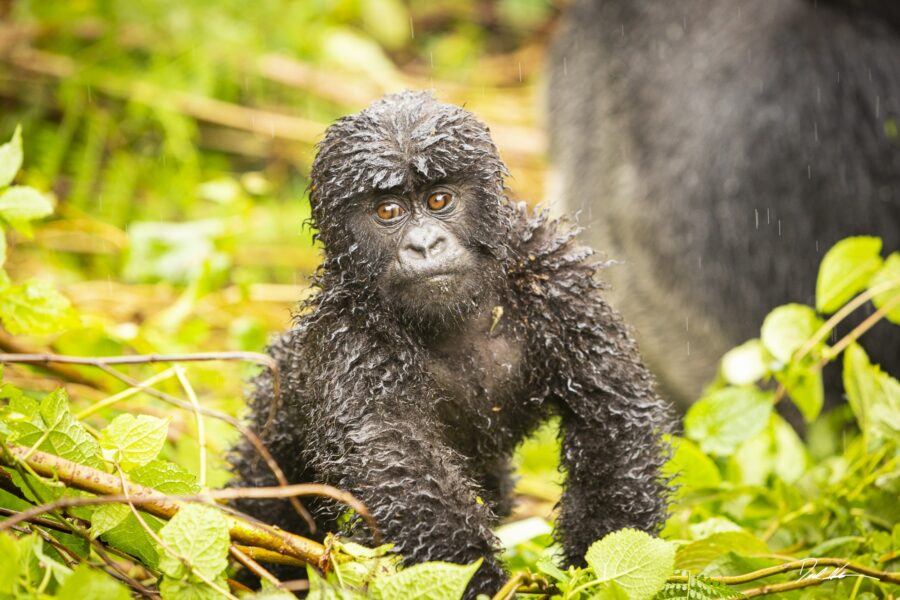
(Derek Nielsen Photography | Luxury fine art open edition print – Electric Rain)
Each country runs its system a little differently, but all permits are administered through a government agency. If you are trying to acquire your permit without a travel agent each of the sites below will allow you to purchase directly through them.
In my experience with this sort of permit, it is easier to go through a travel agent or tour operator. Permits are readily available during the wet season or “low” season, but it would be a good idea to secure your permit six months in advance. The last thing you want to happen is to book a beautiful, life-changing trip only to find out there are no more permits available.
What items to pack for gorilla trekking?
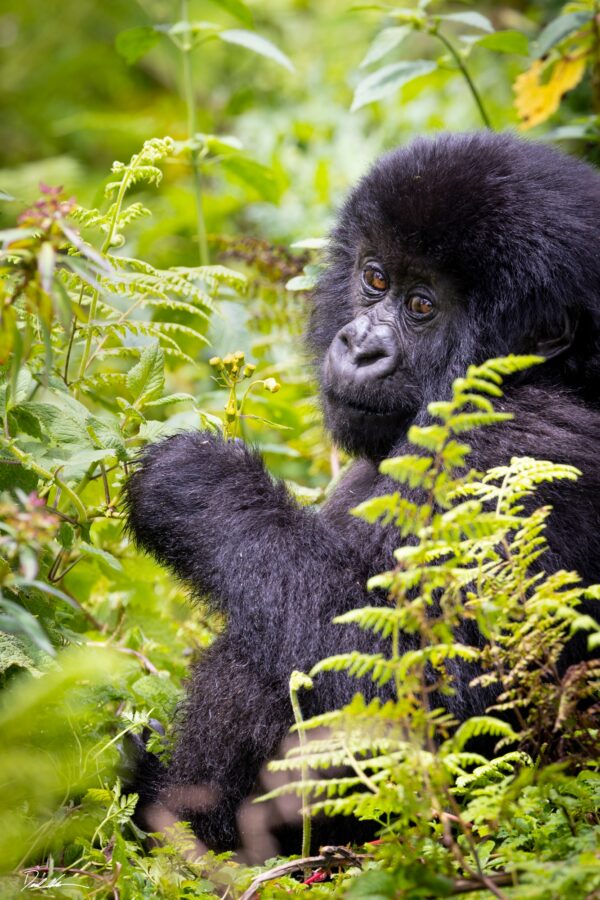
(Derek Nielsen Photography | Limited edition fine art print of 50 – Kwizera)
Trekking mountain gorillas is no different than what you would bring on a normal hike. The main difference is dealing with potential wet weather. This list is full of great suggestions, but feel free to use it as a base on what to bring, depending on your personal preferences. I have no affiliation with any of these brands. These items have stood the test of time for me, and I trust them for my outdoor needs. I am a man, so all my recommendations will be for men, but all of these companies make equally impressive women’s options, I just can’t speak to what I don’t personally use. By clicking the links, you can explore their sites further.
- Hiking boots – A good pair of hiking boots can be your best friend, and a bad pair can be your worst nightmare. If you have a pair, awesome, bring them. If you don’t, I recommend picking up a pair 2-3 weeks before your trip to allow time to break them in. Make sure they are a perfect fit for your body. Everyone is built slightly differently. I prefer Salomon hiking boots. I have three pairs and my original pair from 12 years ago is still rock solid. You will want something supportive about the ankle yet allow you to move. Waterproof is a must for trekking with gorillas, particularly during the wet season.
- Layers – If you are anti-synthetic clothing, this trip might make you a believer. When hiking any mountain or volcano on earth, temperatures change by the minute. There is a good chance you will find yourself taking on and off layers most of the day. Depending on how your body holds or generates heat while exercising can be a challenge to your wardrobe.
- Durable breathable pants – during your hike, you will come across several changes in vegetation. If you have never heard of stinging nettles, you will be glad you have pants to protect you from them when you learn firsthand what they are. They are a spiny plant that leaves an irritating sting for about 10 minutes on whatever skin surface they come in contact with.
- Durable breathable safari shirt with sleeves – On my last trip I was constantly rolling up and down my sleeves to keep myself cool while resting but rolled down the sleeves to protect my arms while hiking.
- Synthetic base layer – This layer will be in direct contact with your body, and it’s a good idea not to wear cotton because of how cotton absorbs moisture. I prefer Patagonia base layers because of their performance and commitment to conservation and fairtrade stance.
- Moisture-wicking hiking socks – This is an often overlooked aspect of hiking essentials. Having comfortable socks that allow moisture to escape your boot and pull moisture off your skin means fewer blisters.
- Breathable rain jacket – If you haven’t guessed by now there is a good chance you might get wet while trekking with gorillas. Don’t be deterred through is all part of the fun and can lead to some great photographs. Having a breathable rain jacket is very nice to have because you will be generating moisture from the inside while fighting it from the outside. The last thing you want to do is just cover yourself in plastic, single-use, Pancho. You will get hot, and sticky, and it will take away from your experience because of their awkwardness.
- Breathable rain pants – This is nice to have but not necessarily a need to have. They will come in handy during a big downpour and can easily be stored in your daypack.
- Lightweight daypack – Unless you are a photographer like myself, it is a good idea to bring a small daypack to carry all your precious belongings. This will free up your pockets allowing you to focus on the joy of the hike.
- Trekking poles – Don’t worry if you don’t bring them you can rent or buy some in town before your hike. They make some really beautiful carved hiking sticks with little gorillas carved into them that break down into several pieces so you can take them home as a souvenir. Unless your tips on your trekking poles are permanent, I recommend taking them off so they don’t get sucked into the mud while trekking. Leave no trace.
- Gardening gloves – This is a weird but important one to add to your list. Along your trek, you will come across many different types of vegetation that have thorns. At some point, you may need to reach out and grab one to save your balance. Gardening gloves will save you from some pretty uncomfortable moments.
- Binoculars – As with any trip into nature, a good pair of binoculars is never a bad idea. This region has over 180 bird species recorded. While the main reason for the trek is to find mountain gorillas, the opportunity to find other incredible species is abundant.
- Sunscreen and bug spray – this is for those who are sensitive to both.
- Camera – For me, you can have the rest as long as I can bring my camera. These are the true words of a photographer. In all seriousness, though, it is a really good idea to bring a decent camera to capture all the great memories packed into your adventure. I listed mine in the link but you don’t need to go out and buy several thousand-dollar cameras for the sake of getting decent photos. Most new cell phones take pretty decent video and photos to begin with. Another option, I do this all the time, is to rent your camera gear. I’ll get into details below on what camera gear should be considered for serious photographers.
- Medication – a travel bug can hit your gut at any time. I highly recommend bringing both antibiotics and Imodium on this trip. Most of the time, permits are non-refundable. Please do not be heartbroken by a bad stomach when a dose of medication would at least be able to get you to experience something incredible before running back to the bathroom.
What is gorilla trekking like?
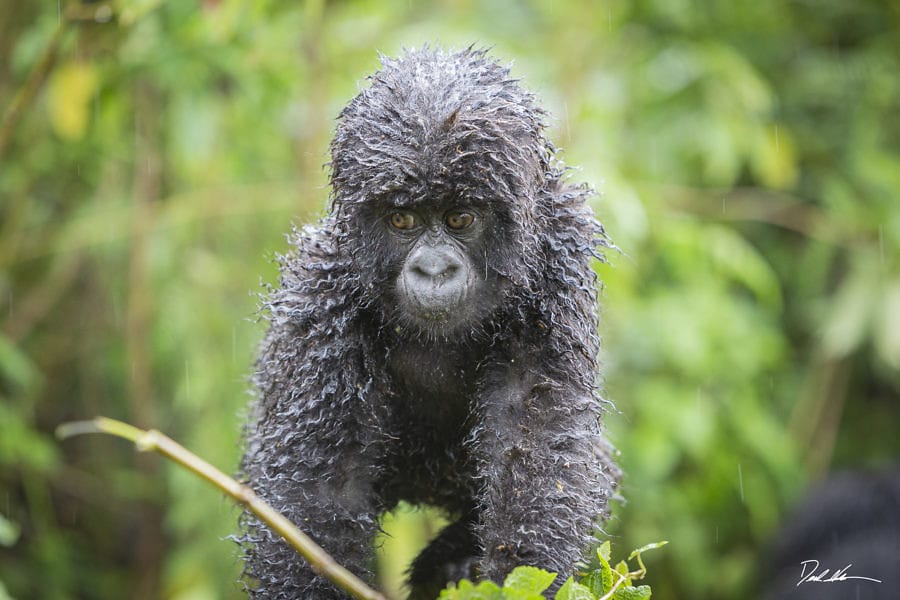
(Derek Nielsen Photography | Limited Edition Fine Art Print of 50 – Mr. Mischievous)
Trekking with mountain gorillas is truly a life-changing experience for many. The day starts early, with usually a wake-up call at 6 am if you are staying at one of the lodges close to the national park. I recommend eating a full breakfast because you don’t want to bring lunch with you on the hike. Depending on your national park, your driver will pick you up at your lodge and drive you to the park entrance for a briefing. During this briefing, you will be assigned your gorilla family and meet your trekking group. Your trekking group will be with you during the entire visit. This is a great opportunity to meet fellow like-minded travelers. I have personally always enjoyed the conversations inside of my trekking groups.
After your short briefing, you will get back into your jeep and drive toward the specific area where your trek will begin. Your driver will stay with the jeep, handing you off to your lead ranger. Here, you will also have the opportunity to hire a porter to assist you with anything you need. (Porters typically run USD 15 per day, and any tip is welcome) At first, your journey will take you through cultivated land where villagers work the farms. Expect to see smiles from the youth and mixed reactions from adults. All friendly, but imagine having to smile politely at everyone who walks through your backyard.
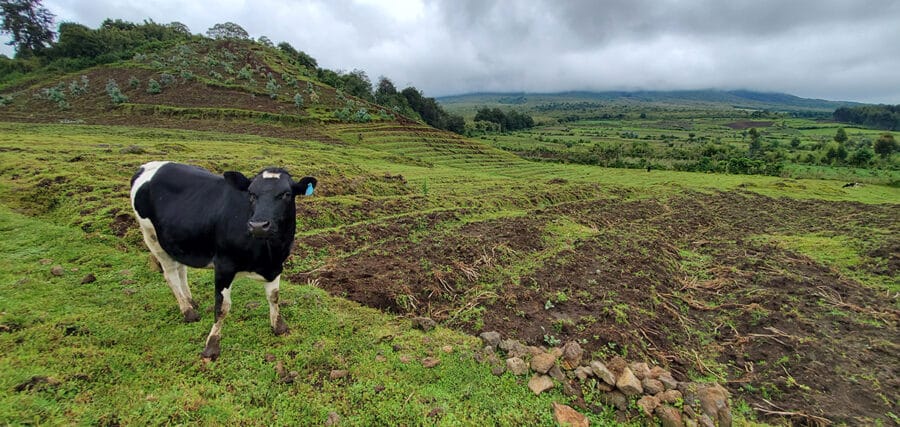
(Derek Nielsen Photography)
After about 30 minutes or so of slow uphill walking, you will arrive at the parking barrier. Here, you will have time to have a quick snack, drink some water, adjust your layers, and triple-check your camera gear. You will also receive your second to the last briefing on what will be found inside the park. Here, you will also pick up your security detail. Don’t be alarmed. This is mostly to protect you from the off chance you encounter an angry buffalo. After a quick introduction to the rest of the team, the fun begins!
Often, the first part of the journey leads through gorgeous bamboo forests lush with green shades and a sweet smell in the air. The ground is often saturated with moisture, making it a little challenging to navigate but the bamboo acts as a nice set of strong grips to hold onto. Once the bamboo forest is passed, the majority of trekking experiences happen in open clearings between patches of forest. Because the gorillas have free range to move, it is hard to completely predict from here how long the trek will take. Most often, if you are on a short or moderate trek you will meet your gorilla family within 30-90 minutes of clearing the initial bamboo forest.
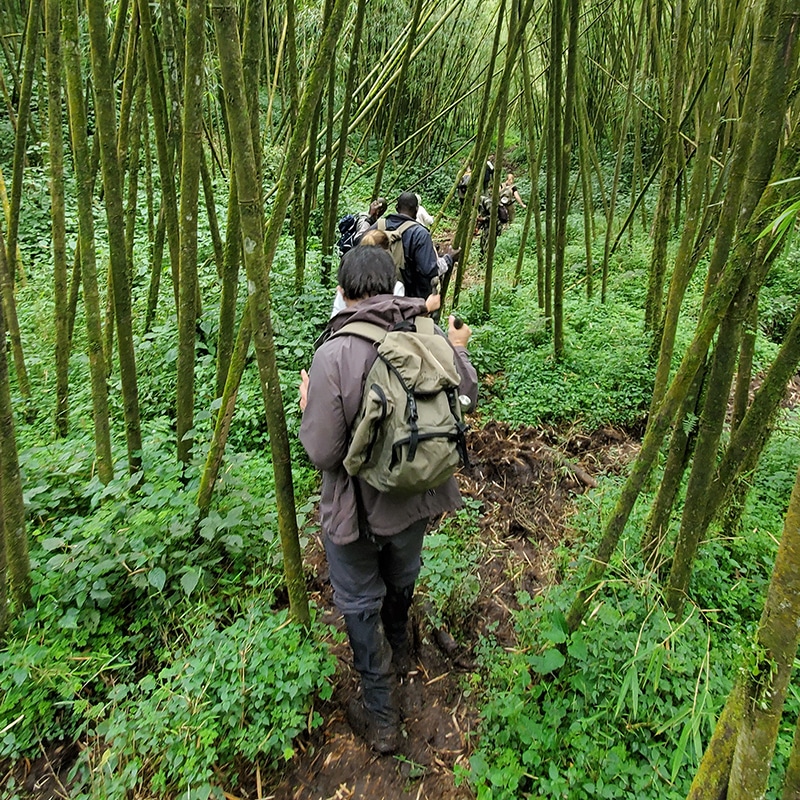
(Derek Nielsen Photography)
Your lead ranger is in constant contact with the trackers following the assigned mountain gorilla family. They will give you a 10-minute warning and typically stop one more time around then to allow you to have more water or a quick snack if needed.
Finally! You have arrived! This is where the real adrenaline kicks in. All trekking poles, backpacks (minus camera bags with no food in them), extra clothes, and anything else you don’t want the gorillas getting a hold of is left behind with the trackers. Your heart starts pounding and the 60-minute clock begins. The lead ranger will escort you to your family. Because they are wild animals every encounter will be different. In my first encounter, the silverback of the group came over to several of us to check us out first before letting the rest of his family visit. In my last encounter, the silverback never paid any attention to us.
(Video courtesy of Steven Ngowi)
As the minutes pass, your memory cards fill quickly with images. Make sure you take a few moments to observe them without a lens or phone in your hand. It will blow your mind where you are standing. On a mountain, in the wild, with mountain gorillas. Gorilla trekking is an experience you will never forget. They quickly become indifferent to your presence as the groups we are allowed to visit have been habituated to humans. Children play, mothers feed their young, and right before your eyes, an entire family dynamic unfolds. They may touch you, so don’t be scared, but also don’t touch them back. This experience will stay with you for the rest of your life.
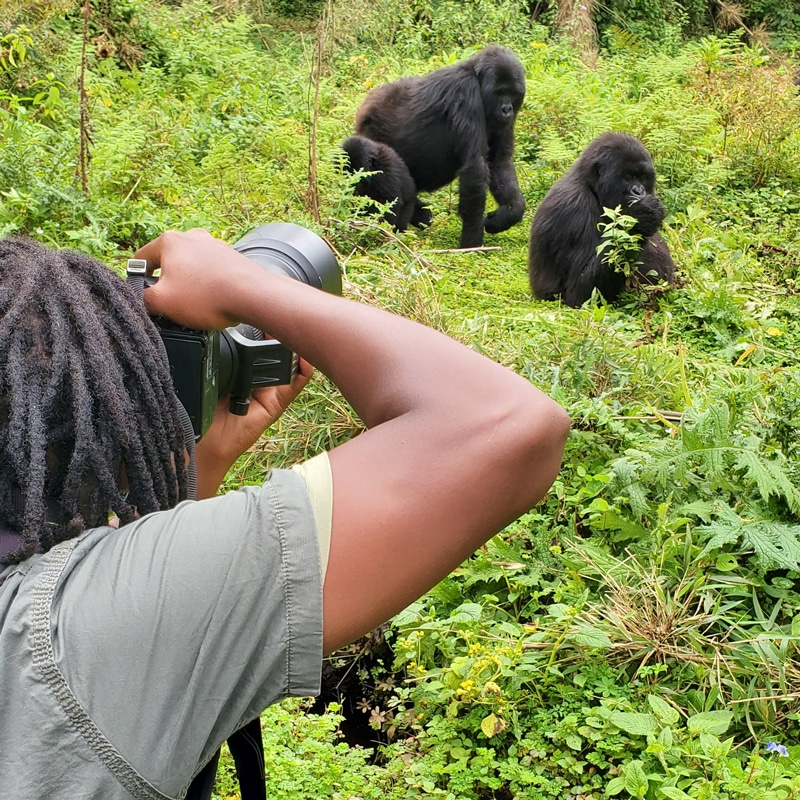
(Steven Ngowi with Ndifo Safari)
After the 60 minutes of adrenaline-filled smiling and picture-taking passes, your lead ranger will announce to the group it is time to go. It is surprising how quickly an hour passes. They will lead you back to your belongings. This is a great opportunity to thank the trackers ( $5-$10 per tracker is a generous tip; remember, this is going directly toward gorilla conservation). Without them, it would not be possible. This is also a perfect time for a group photo. You will not find a better time to capture all the big smiles coming off the high of your experience.
Your walk back down the mountain is leisurely. No one is in any rush. Snap as many remaining images as your memory card will hold, or just take it all in. After passing back through the cultivated land, you will say goodbye to your porter and your ranger. As the saying goes, “tip what your heart tells you”. But…If you are looking for a baseline. A tip of an additional $5-10 USD or more based on your budget and their level of assistance for your porter will be welcomed. For your lead ranger, $50-100 per person is a good place to start. Try to budget for this expense before you arrive. I can not stress enough how much this helps the community. One of the only reasons the mountain gorillas are still here is because they are more profitable to the community alive than dead. Not all that long ago, many trackers and porters made money poaching wild animals as a means to provide for their families. They have learned about the power these animals hold for their community and now devote their lives to helping protect them.
Where to stay when hiking with mountain gorillas in Rwanda
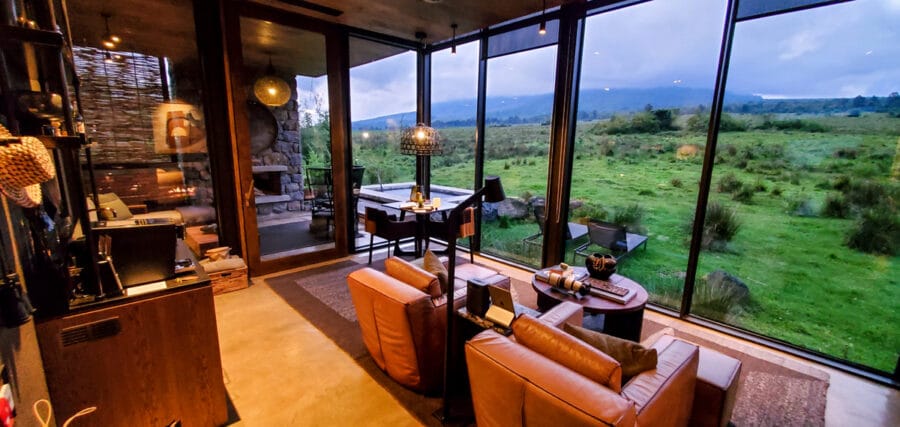
I have not been to DRC or Uganda yet, so my suggestions will be all based in Rwanda. Around Volcanoes National Park, there will be several options to fit all budgets, and all are extremely safe.
Singita Kwitonda Lodge – This may not only be the most impressive lodge in the park region, but it may also be the most impressive lodge I have ever stayed at. From the moment you arrive until the moment you leave, the staff not only greets you by name but also treats you like you have arrived home. After being escorted to my private villa suite, I enjoyed a hot, relaxing shower looking over the national park from my sprawling master bath. Every detail is elegantly covered, from the personalized stationery alongside your bed to the handwritten welcome note left by the staff. My gorilla family was even printed out for me on a cute little note card for my records.
The room itself is more like a small house. Upon entry, you are greeted with floor-to-ceiling windows giving you dramatic views of the lush green mountains. The 178-acre property runs right up to the boundary of the park, giving guests an unobstructed view into nature. Each of the seven private suites has a comfortable outside seating area decorated with a sectional couch, fireplace, and hot tub for relaxing after a long day of excitement.
Back at the main lodge, an expert chef with the kindest personality serves up decadent meals from local favorites to traditional global cuisine. His spread on local entrees is not to be missed, although his risotto almost made me never want to leave. The tasteful, sophisticated architecture will make you want to remodel your home to mimic the style. The restaurant and bar have both indoor and outdoor seating options. My favorite room was the conservation room. This room is filled with artifacts from the early conservation explorations of Dian Fossey, along with other fantastic books, magazines, and a workstation to view your photos. The day before your gorilla trek, guests meet in the room for an optional briefing to learn from one of Singita’s expert conservationists for a more in-depth look into gorilla trekking, conservation, and their habitat.
Gorilla Mountain View Lodge – In 2016, during my first trip to Rwanda and Volcanoes National Park, I had the pleasure of staying here. For me, my experience was quite enjoyable. This is certainly a step down from the luxuries of Singita. However, this is a fantastic place to visit and certainly more budget-friendly. The rooms and lodge are modestly decorated with local art and prints. Each room has a small fireplace perfect for setting a romantic, cozy mood after a long day of excitement. Each evening members of the staff bring loads of energy to a thrilling tribal dance accompanied by drumming and singing. They pull you in and make you shake off your shyness for an inclusive experience if you are willing. For those on a strict travel budget, staying in town is certainly an option being that it is only a 10-minute drive to the park entrance.
How similar is gorilla trekking to chimpanzee trekking?

From my own experience, gorilla trekking is much easier than chimpanzee trekking. Chimpanzees in many parts of Africa have a growing fear of humans due to habitat destruction, poaching, and competition for natural resources. On my most recent trip to Rwanda, I had the pleasure to do both in a relatively short amount of time. If gorillas are a four on my previously mentioned scale, then chimpanzees are a solid 6. They cover more ground, while gorillas typically just lay around in one area. Gorilla families are relatively small compared to chimpanzee families, and gorillas are almost strictly vegetarian, the need to search for food is less involved. Check out my previous article TREKKING WITH CHIMPANZEES IN RWANDA | MY DETAILED ENCOUNTER for a detailed description of a day hiking with chimpanzees in Rwanda’s Nyungwe National Park. Each experience is so different. Both offer exciting adrenaline-filled inside looks into some of our closest relatives lives.
Photography recommendations to photograph gorillas
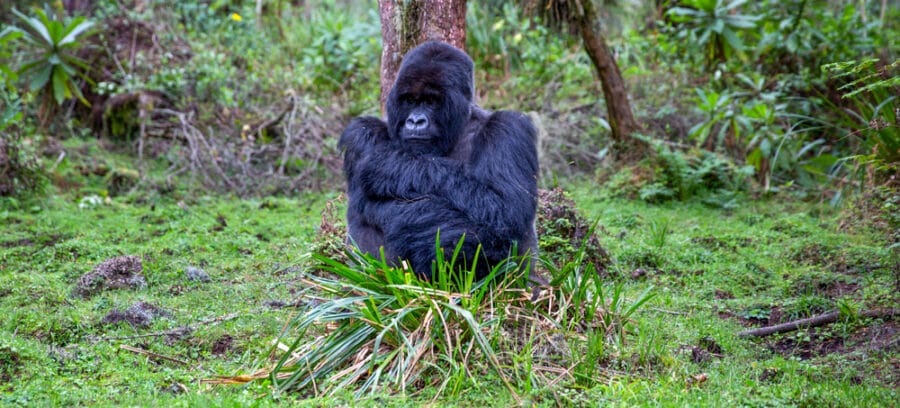
As a professional nature photographer, I will break down my most important photography gear recommendations as well as some basic camera settings for razor-sharp images in potential low light. Photographing mountain gorillas can be more difficult than you think.
I am the owner of a black dog. Why does that matter? Photographing black dogs or chimpanzees or mountain gorillas can be difficult. Here’s why. Black animals don’t tend to stand out as much when being photographed. Details can get lost in their dark fur. The color black by nature, absorbs light. Now, sprinkle in the fact that you will be taking photographs in a forest with potentially cloudy or rainy skies. I’ll take it one step further: your subjects won’t stay still. It is a good idea to study all things related to nature photography before every trip, no matter how seasoned of a photographer you are.
-
Camera Settings for Gorilla Photography
- High Iso – something between 2000 and 5000 should do based on your camera’s ability to handle high iso settings. I would rather have a memory card full of grainy images than blurry images if you are left with a decision between the two. Grain can be fixed, but blur can not be.
- Shutter speed – my gold standard for the shutter speed when working with animals is 1/1000 to 1/2000 of a second of shutter speed. This ensures the motion will be frozen, and your image will not be blurry.
- Wide aperture – f/5.6 or larger. Start by using the widest aperture your camera will handle. This will let the most amount of light in to allow for faster shutter speeds to help freeze motion, as mentioned before.
-
Camera Gear for Gorilla Photography
- Telephoto lens – I recently rented the Canon RF 100-500mm f/4.5 IS USM for portrait work with gorillas. I was incredibly impressed with the range this lens could cover, opening up more compositions than expected. I also, on my first trip, used the canon 70-200 f/2.8 ii for portrait work and the results are incredible. Typically these are not the ideal portrait lenses in a camera bag, however, if you can’t get close to your subject safely, they do the trick. Remarkably well, I must say.
- Landscape lens – portraits of gorillas are incredible but it is so refreshing to see a photographer capture the entire feel of the experience. Sticking with a lens that covers a wide range of compositions, the Canon RF 24-105mm f/4 L IS USM allowed me to get creative. Sure, would I love to have all day to find incredible compositions with a 50mm or 80mm, yes? But you get one hour and if you are anything like me you will want to make the most of it.
- Second camera body – If for whatever reason your first camera dies….oh it happens…it is always a good idea to bring a rental backup. You have traveled around the world to photograph gorillas; don’t let your entire experience be captured on a camera phone. They are getting better, but they are still not real cameras.
- Extra charged batteries – Don’t feel like I need to expand on this too deep, but please don’t forget to bring extra batteries for your camera gear. Not only have batteries, but make sure they are charged.
- Extra memory cards – It is quite surprising how many images a person can take of one subject in an hour. Today’s cameras are getting more and more powerful, eating uploads of memory on cards. Make sure you have at least 2 5ooGB cards with you. Buy them at home because they will be very expensive in Africa.
How many gorillas are there left in the wild?
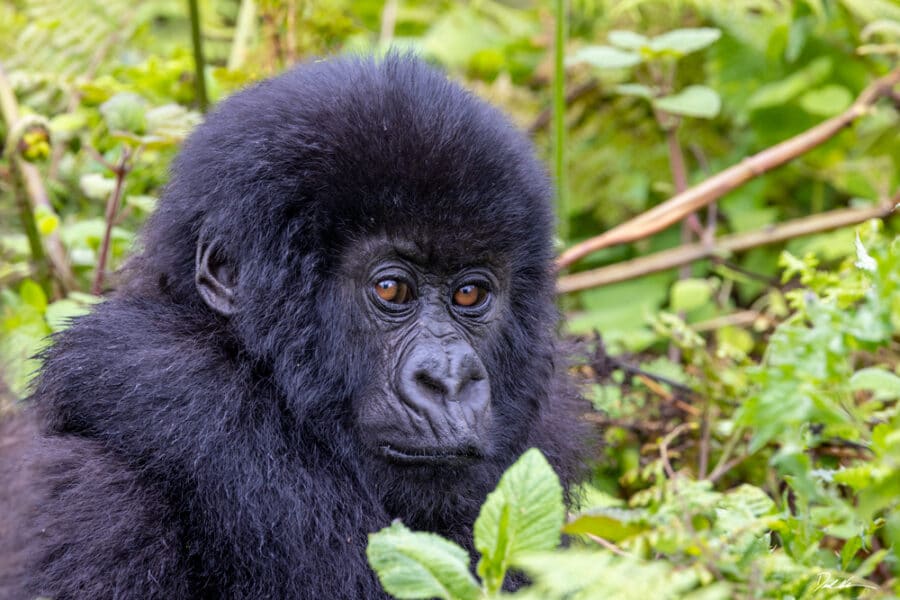
According to the International Gorilla Conservation Programme, as of 2022, an estimated 1063 mountain gorillas are remaining in the wild. Fortunately, the numbers of gorillas are on the rise due to vigilant conservation efforts across all three countries. This does face a new challenge unforeseen by most involved in conservation. With the rising number of gorillas in the wild, where will they go once they run out of room to expand due to human development?
The history of gorilla conservation
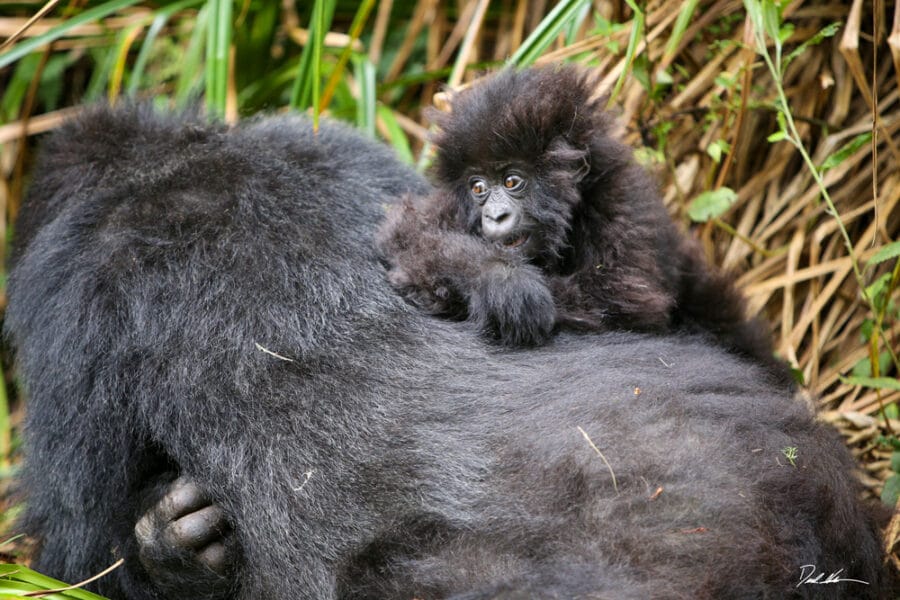
This portion of the article is the closest to my heart as a conservation photographer. As I stated earlier, my first encounter with mountain gorillas completely changed my life. I wanted to become an ambassador for their fight for survival. To share their story with the world. A conservation success story.
Way back in 1929, the Belgian colonial government established Volcanoes National Park. They went on to screw up so many things, but I’ll save that for another article. In the 1960s, shortly after George Schaller and Dian Fossey began their respective research on mountain gorillas, the park was divided into two parts. This split the park into two, half falling in Rwanda (Volcanoes National Park) and the other in DRC (Virunga National Park). In 1959, George Schaller spent a year conducting fieldwork, culminating in one of the first scientific, literary works called “The Mountain Gorilla”.
In 1967, Dian Fossey arrived in Schaller’s camp inside the Congo only to be chased out by political unrest. She retreated to the Rwandan side of the Virunga Mountains to set up her research camp. Her first important task was to habituate mountain gorillas to humans. She needed them to feel comfortable around her, not change their behavior, and let her observe. To do so, Fossey visited groups of gorillas acting as they did. She would climb around on the ground and mimic the vocalizations gorillas expressed while feeding and playing. She knew these sounds were not threatening and would not provoke an attack.
As the gorillas became more and more comfortable with Fossey’s presence, she could expand her research and the research of George Schaller. She drew their signature nose prints to help with identification and then began to fully understand the complex social organization. As the research became more complex both on a scientific level and organizational level the work took on a life of its own. When Dian Fossey was murdered in 1984, her work continued to live on through her team and supporting researchers.
While the physical center Dian Fossey originally set up no longer exists, the Dian Fossey Gorilla Fund lives on in her honor. Their work has been instrumental to the rebound of gorilla populations across the region. Their efforts and the efforts of other organizations have returned the population from approaching 300 individuals to now over 1000. The revival of mountain gorilla populations is one of the greatest conservation success stories of the last century.
Today, celebrities like Ellen DeGeneres, through The Ellen Fund, have picked up the fight. In February of 2022, The Ellen DeGeneres Campus of the Dian Fossey Gorilla Fund opened its doors to the public. With three main pillars, research, education, and inspiration, the campus gives a new permanent home for conservation efforts in the area. I am so proud of Ellen and the work she and her team are doing. They get it. 2,310 workers were employed building the campus, 99% were Rwandan and 21% were female, over $14,000,000 was invested into Rwanda, and over 250,000 native plants were propagated. Other notable celebrities were generous with their time and money, including Leonardo DiCaprio. I can’t tell you how important, whether you love them or not, getting celebrities involved in conservation gets the message out in ways non-famous people can’t.
My passion for wildlife photography
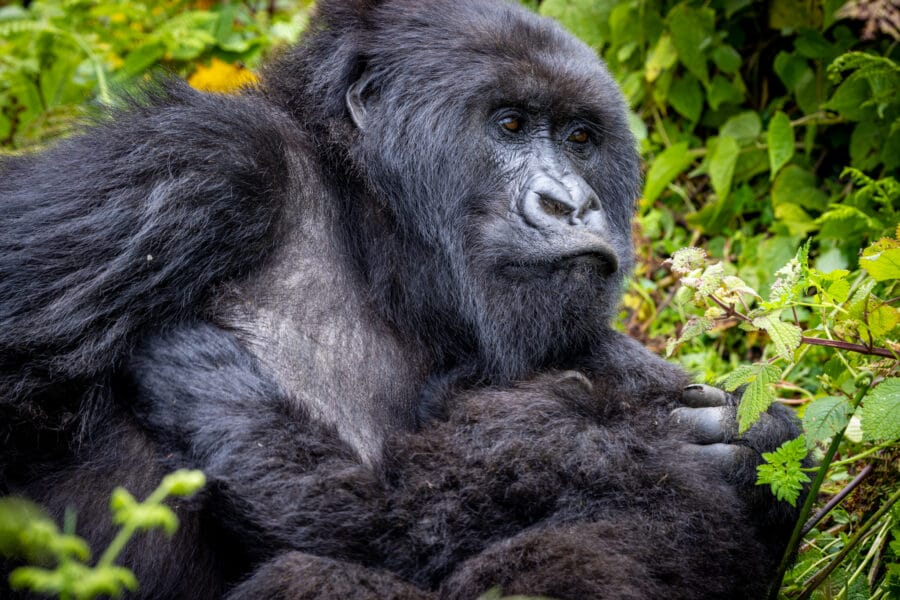
Gorilla trekking changed my life. There are only a few moments, looking back, where something unexpectedly moved me the way my experience with gorillas did. As our planet changes and evolves over the coming decades, ecotourism will be one of the best ways to save wild animals. If the local community can profit from what they have before they destroy the forest, animals, lakes, and rivers, stories like the survival of the mountain gorillas will be more common. Gorilla trekking is one of the most intimate wildlife experiences in the world. It works because of the hard work and sacrifices of the dedicated men and women who devote their lives to protecting them.
My work focuses on all wild animals, beautiful landscapes, and cultures on all seven continents. From my diverse collection of images from all over the world, I have hand-picked grassroots environmental organizations to support with my limited-edition luxury fine art. Through my website, I donate a minimum of 10% of every fine art piece sold directly to these organizations so that I can continue to protect what I and most of us love, nature.
All of my nature work in Africa is sold to help Dr. Gabby Wild and her foundation. She is one of the kindest, most passionate, and most skilled wildlife veterinarians in the world. Her organization is devoted to saving wild animals as well as educating people about conservation on many levels. Our choices in life have a daily impact on the health of this planet. Please travel responsibly. Research and vet your tour operators to know they are putting nature’s best interest first. Travel can be the best form of education our soul will ever experience. Get out there and live the wild life.
Written by – Derek Nielsen
WHAT IS THE COST OF NOT PURSUING YOUR DREAM AND BECOMING A GREAT PHOTOGRAPHER?
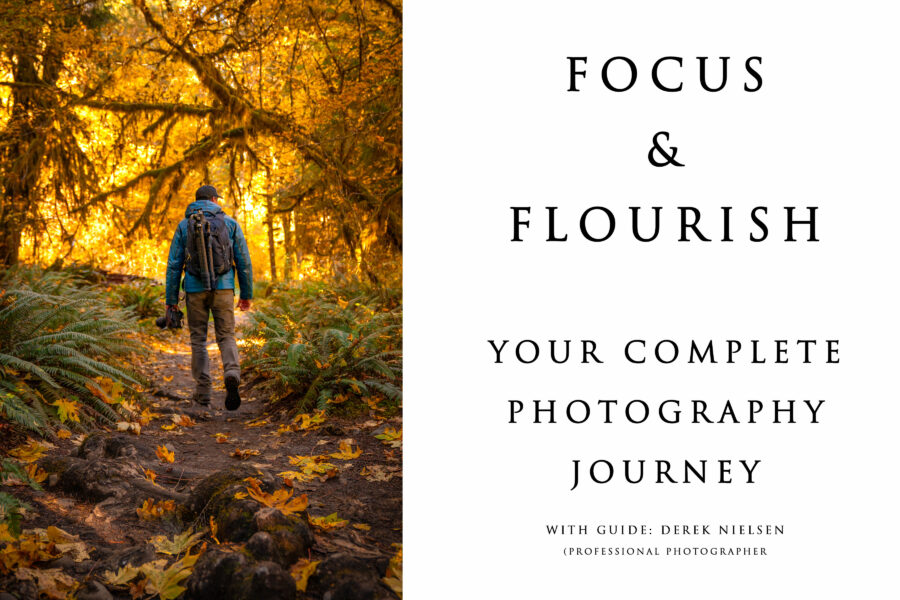
LEARN MORE
Imagine always wondering what would have happened if you had only invested in yourself and your passions. Think about how quickly life goes. Don’t wait for tomorrow to do the things you have been thinking about doing! Take the trip. Start that business. Invest in yourself. Without photography, I don’t know what my life would look like, but it would be a lot less inspiring. Don’t let another day go by without creating the life you truly want.
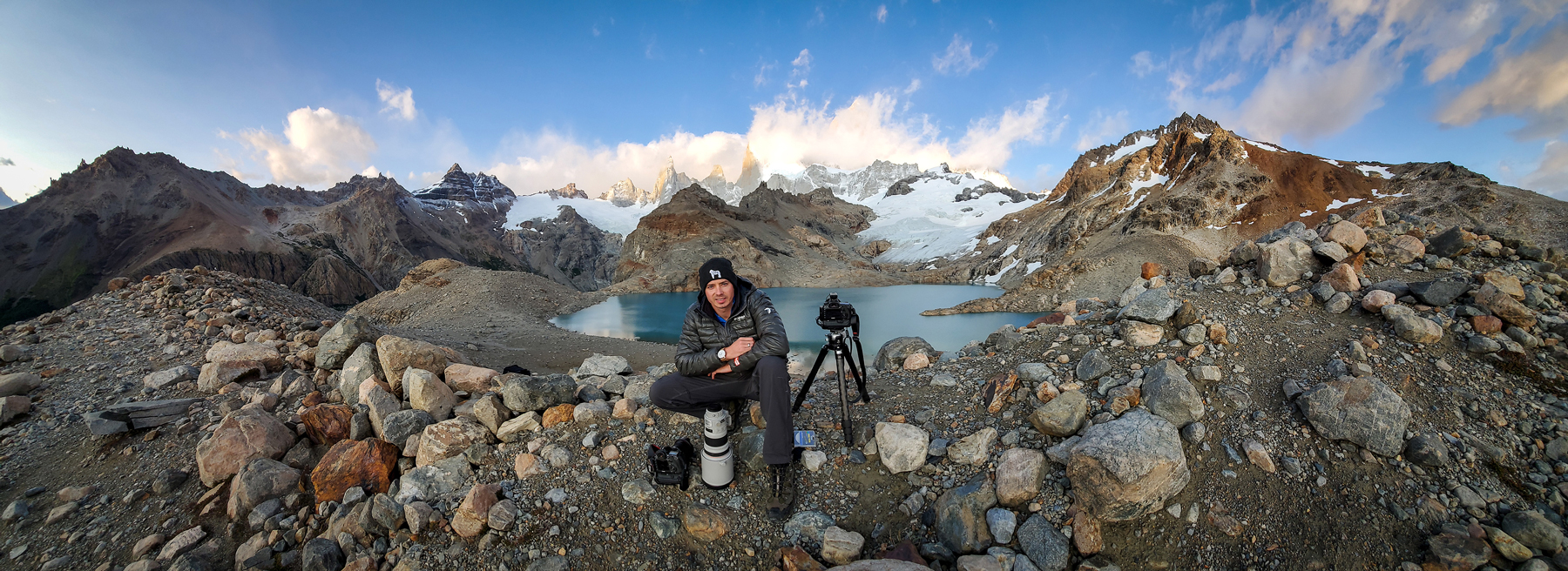
Hello! I'm Derek.
DEREK NIELSEN PHOTOGRAPHY RAISES AWARENESS ABOUT THE GLOBAL NEED FOR CONSERVATION THROUGH PHOTOGRAPHY AND DONATES UP TO 15% OF ALL SALES BACK TO ENVIRONMENTAL ORGANIZATIONS AROUND THE WORLD.
